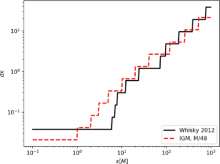
Abstract
Binary black hole (BBH) mergers provide a prime source for current and future interferometric gravitational wave observatories. Massive BBH mergers may often take place in plasma-rich environments, leading to the exciting possibility of a concurrent electromagnetic (EM) signal observable by traditional astronomical facilities. However, many critical questions about the generation of such counterparts remain unanswered. We explore mechanisms that may drive EM counterparts with magnetohydrodynamic simulations treating a range of scenarios involving equal-mass black-hole binaries immersed in an initially homogeneous fluid with uniform, orbitally aligned magnetic fields. We find that the time development of Poynting luminosity, which may drive jetlike emissions, is relatively insensitive to aspects of the initial configuration. In particular, over a significant range of initial values, the central magnetic field strength is effectively regulated by the gas flow to yield a Poynting luminosity of 1045−1046ρ−13M82 erg s−1, with BBH mass scaled to M8≡M/(108 M⊙) and ambient density ρ−13≡ρ/(10−13 g cm−3). We also calculate the direct plasma synchrotron emissions processed through geodesic ray-tracing. Despite lensing effects and dynamics, we find the observed synchrotron flux varies little leading up to merger.